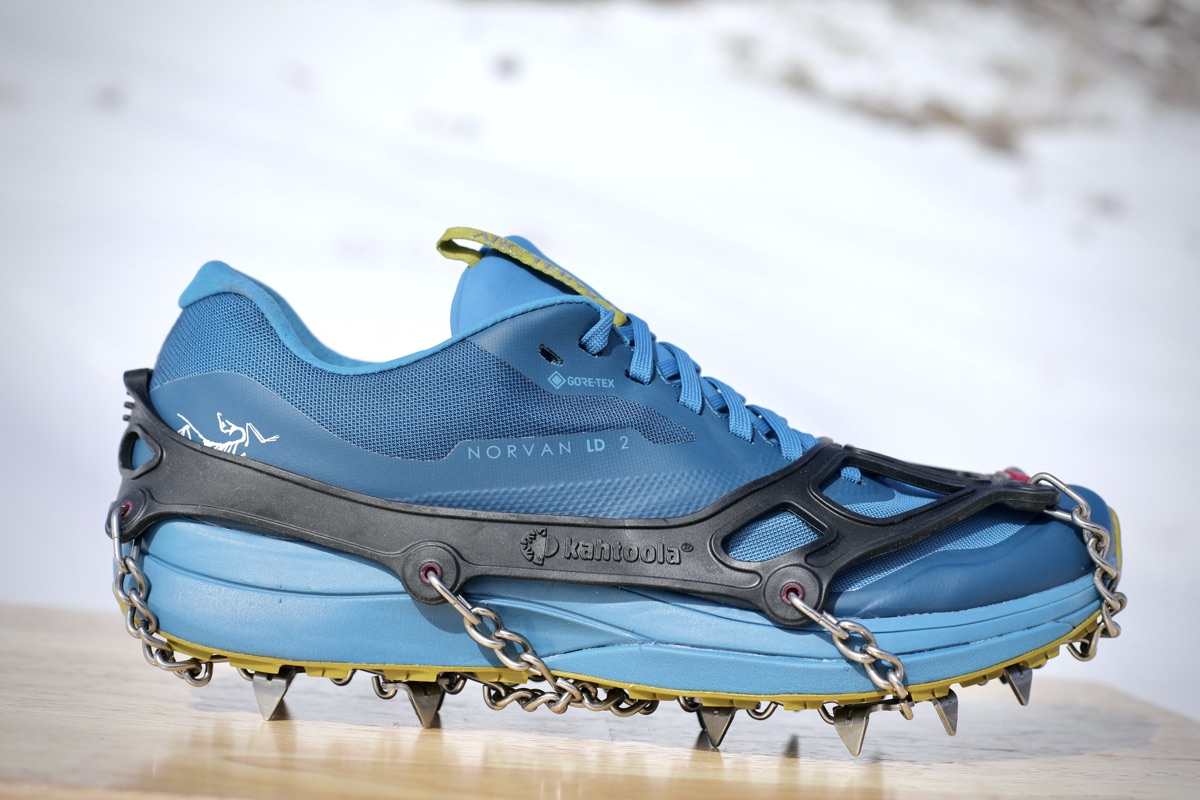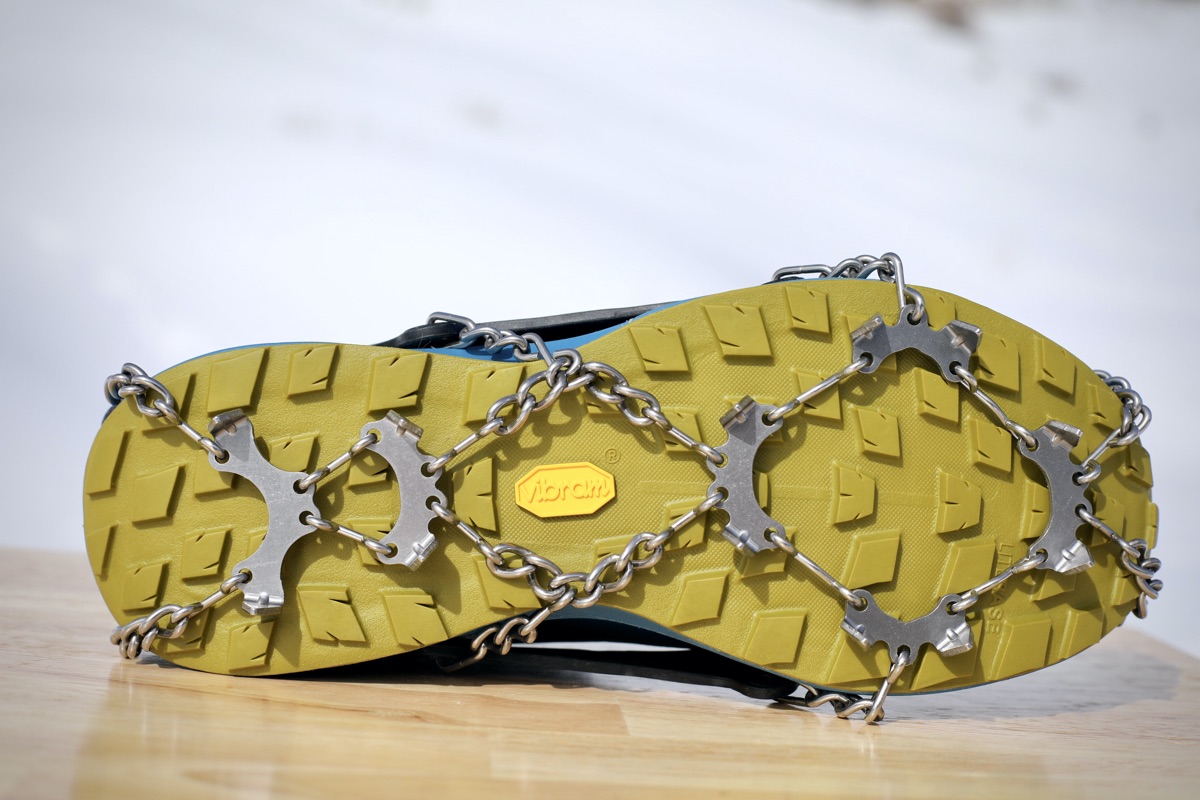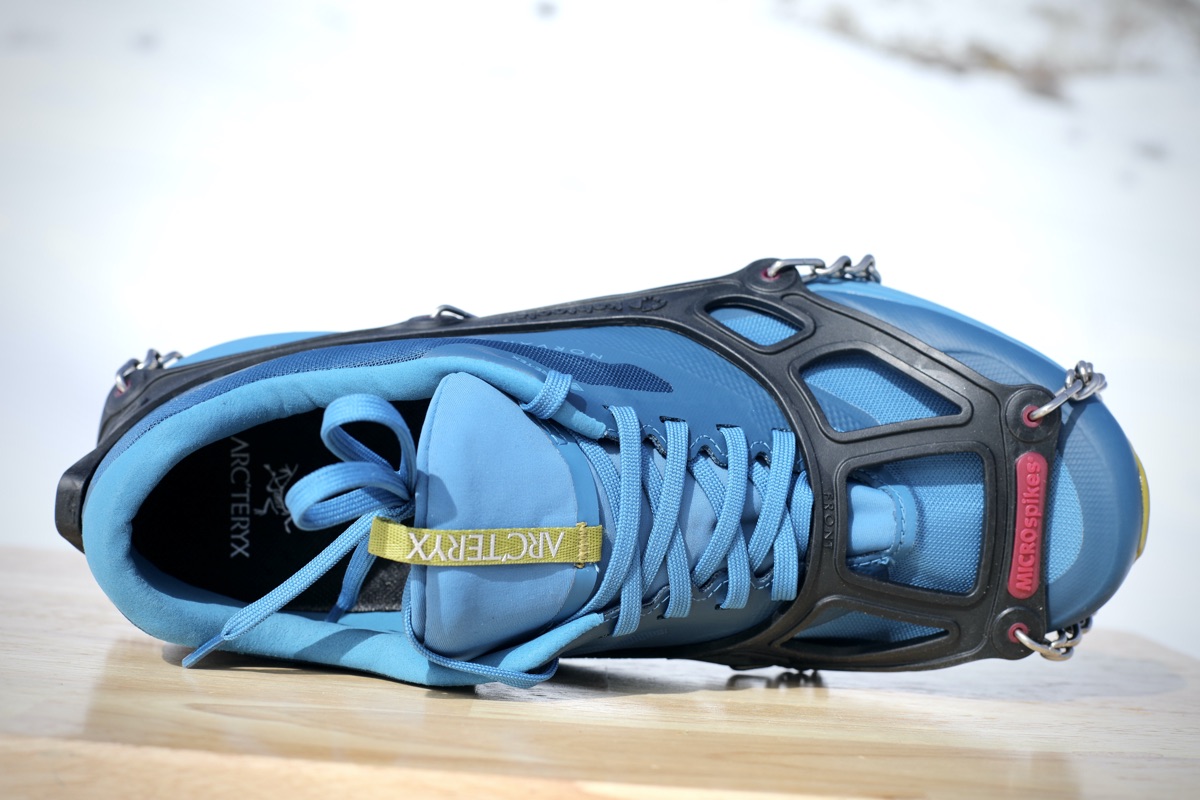Kahtoola MICROspikes ($75) have been a leader in traction devices for over a decade. With spring races on the horizon as well as a desire to stay mentally and physically healthy this winter, I put the 2021 version to the test for this review.
I live in Colorado and the state is having its usual mercurial winter, so I’m facing trails with decent vertical relief, well-packed snow, icy stretches, and patches of dry dirt and rocks. This variability means I prefer to have my standard trail shoes and removable running spikes for ice and snow along rather than a pair of screwed or studded shoes. Aggressively spiked or toothy ice cleats make a huge difference in both my confidence and abilities on the trail. I’ve long been a fan of MICROspikes for gnarly conditions and steep terrain, and the newest version is even better due to a decrease in weight and an increase in flexility of the harness which makes packing them away in a small pack or pocket much easier.
MICROspikes are the gold standard of backcountry and mountain-running traction in frozen conditions. The next step up is crampons, and if true crampons are actually needed, I’m definitely not running. Kahtoola, based in Flagstaff, Arizona, introduced their first product to the outdoor market in 1999 with the KTS Crampon. They continue to advance their mission—to enhance safety and security on alpine adventures in lightweight, flexible footwear while being socially and environmentally responsible—with a line of various traction devices and gaiters.
Shop the Kahtoola MICROspikesKahtoola MICROspikes Design
Kahtoola MICROspikes excel on steep alpine adventures as well as hills, dales, and flats crisscrossed with ribbons of hard-packed snow and shiny ice flows from nearby mountain streams. The 3/8-inch (1-centimeter) triangular spikes bite aggressively into ice and snow yet come right back out easily for the next step. They allow for confident running and hiking where consistent freeze-thaw conditions turn snowy trails into luges that, without MICROspikes, can result in a slip-and-fall by an unsuspecting runner. The 12 heat-treated, corrosion-resistant, stainless-steel spikes handle incursions with rocks and roots with ease should a brief dry patch interject your icy and snow-packed journey.
The welded stainless steel chains that link the spikes together across the bottom of the shoe move independently and are very sturdy yet don’t impede natural foot movement in any way. These chains are connected to the elastomer harness in 8 places, and the harness is what encompasses your shoe’s upper. This whole package allows the flexibility which enables the MICROspikes to collapse into a 5 x 3 x 2-inch tote sack with a drawstring which is absolutely necessary if you end up stashing the spikes in your pack—save your pack, save your back!
The sizing ranges from small (US men’s 5 to 8/women’s 6 to 9, Euro 36 to 40) to size extra large (US men’s 14-plus, Euro 48-plus). At 6.0 ounces (170 grams) each in a size medium, you can feel them in your pack when you have them stowed away and on your feet when you’re running in them. But the confidence they give you more than makes up for it.
Kahtoola MICROspikes Use and Traction
It’s important to have the right tool for what you do. In my opinion, a pair of Kahtoola MICROspikes should be in any mountain athlete’s winter kit. MICROspikes are for burly trail conditions with packed snow and ice and mountain adventures where crampons aren’t actually needed. They are not designed for thin black ice on streets or paved running—Kahtoola has products better suited for that in their EXOspikes and NANOspikes.
The durability of the Kahtoola MICROspikes is noteworthy, and they come with a two-year warranty. I have a pair of MICROspikes from seven winters ago that are still going strong. The elastomer harness shows no weak points or abrasions, and has maintained its stretch and strength perfectly. With the newest model I received for this review, the harness feels a bit lighter weight, is more flexible, and packs easily into a smaller pack which improves the ease of use on long runs where I stow them in my pack in the sun-exposed sections.
They’re slightly easier to get on and off while standing on one foot than my older pair—both have similar trusty heel pull tabs—but are proving to be just as strong and resilient. The elastomer harness is rated down to -22 degrees Fahrenheit (-30 Celsius) for its elasticity and I haven’t had an opportunity to see what happens below this temperature.
While I would’t trust anything else on my feet while tromping up a mountain trail in winter conditions, there are three small drawbacks to the using the MICROspikes for exclusively running. First, they can feel a bit heavy on the legs over a few or more hours running. This is not something I notice while running, but more so via the cumulative fatigue I feel in my legs afterward. Second, I really don’t like running on longer sections of dry dirt and rocks in them as I tend to catch the spikes on rocks, roots, and more. Because of this, I end up taking them on and off more frequently than something with less aggressive spikes in mixed conditions. Third, when running on packed, wet snow in warmer temperatures, they tend to build up a ball of snow right at the center of the heel and occasionally over the ball of the foot. You remedy this with a quick scuff of the snowball on a rock or by using the opposite foot to dislodge it, but it does require attention.
One important side note: care should obviously be used while wearing pointy objects. The spikes excel at what they do, and you definitely don’t want to put one into the side of your lower calf or into the paw of your trail dog. Stitches will likely be required. Thankfully, I’ve only learned this vicariously.
Kahtoola MICROspikes Overall Impressions
Overall, if I planned to purchase only one pair of spikes for everything I might do in a given winter, particularly since I like to run on steep trails in the mountains, the Kahtoola MICROspikes are it. I don’t run pavement, and I have a pair of screw shoes for when I don’t need much traction assistance. But when it comes to trusting life and limb on burly terrain, the exceptional toothy traction, bomber durability, ease of getting them on and off all my different trail shoes, and the small packable footprint they now have, MICROspikes present a winning argument.
[Note: As of 2021, the Kahtoola MICROspikes are on their fourth iteration. The bottom of this article outlines the design changes since their debut in 2007.]
Shop the Kahtoola MICROspikesOther Winter Running Traction Devices
For more on the subject, check out our Best Winter Running Traction Devices article. You can also check out these individual reviews of traction devices for running on snow and ice.
Call for Comments
- Calling all Kahtoola MICROspikes wearers! Leave a comment to share your experiences with them.
- In what conditions do you prefer to use the MICROspikes, and in what conditions do they not work as well for you?
[Editor’s Note: If you’re affiliated (i.e., an employee, ambassador, etc.) with a brand, please share your relation in each of your comments on this article. Thanks!]





